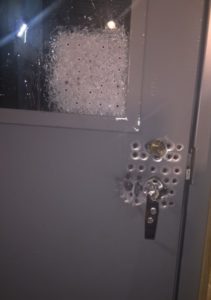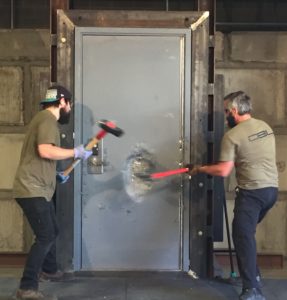What’s the Difference?: Attack Resistant and Forced Entry Bullet Resistant (FEBR) Openings
These two new specialty door products which have recently launched from ASSA ABLOY brands are similar at first glance, yet serve distinctly separate applications, purpose and performance. You can find detailed information about each individually online, but I’d like to share some of the major differences with you from a high level perspective.
Many people mistakenly assume the Attack Resistant opening is bullet resistant. While there is a ballistic portion of the test for this product, the objective is not to stop a bullet, but rather measure resistance after bullets are shot. The testing requirement for the Attack Resistant opening is to remain secure and locked after being shot with up to 60 rounds; 30 to the lock, and 30 to the glass. Conversely, the FEBR opening is bullet resistant to UL752 Level 8, which is equivalent of 5 shots of .308 caliber ammunition fired through a 7.62mm rifle. This is the first testing requirement of each product: the Attack Resistant opening is tested to 5-aa10 standards based on the FBI’s 2014 Active Shooter Report, while the FEBR opening has been tested to Department of State Standard SD-STD-01.01 Rev G (Amended).
The second part of testing requires for both products to sustain a physical attack. The key differentiators between the test methods are the number of attackers, duration of attack, and tools available. The Attack Resistant opening must endure four minutes from a single assailant using their choice of common tools such as the butt of a rifle, a ball peen hammer, a three pound blunt hammer, or a baseball bat to break through the glass or force the lock to open and gain entry into a space. The FEBR opening must endure 15 minutes of attack from a six man concentrated assault team using readily available hand tools such as crowbars, sledgehammers, saws among others not limited to an exact list.
Now let’s compare the complete assembly of each opening. The Attack Resistant opening consists of a wood or hollow metal door (16 gauge face), light kit pre-glazed with School Guard Glass SG5TM, hollow metal frame (16 gauge), option of 4-1/2” standard weight hinges or a continuous hinge, and a mortise lock with latchbolt, deadbolt and escutcheon. The FEBR opening is made up of a thicker/heavier hollow metal door and frame (both 12 gauge), a three point latching exit device, continuous hinge, and threshold – all factory supplied as a full assembly.
So, you might be asking yourself – why not use the Forced Entry instead of Attack Resistant since it’s not bullet resistant? The answer is price, weight, and aesthetics. The Attack Resistant door is perfect for applications in both wood and hollow metal doors, providing the same look and ease of opening/closing as a door with standard tempered glass. The cost to use Attack Resistant assemblies at all door openings of a school wing may equate to the cost of a single FEBR assembly. The Forced Entry opening uses heavier gauge metal and more robust hardware because it is designed for government/military, control and safe rooms, and guard houses. As a result, the FEBR opening is over ten times more expensive than the Attack Resistant opening.
The information above clarifies the difference between Attack Resistant and FEBR openings. If you need a more elaborate explanation of the differences, or want to see the products under attack, watch the actual test videos here: Attack Resistant Openings | Forced Entry Bullet Resistant Openings.
Additional Resources
New Features Earn Attack Resistant Opening Industry Awards


No comments yet - you can be the first!